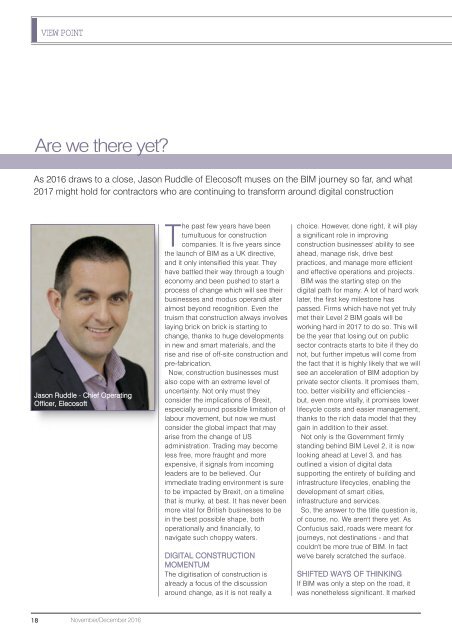You also want an ePaper? Increase the reach of your titles
YUMPU automatically turns print PDFs into web optimized ePapers that Google loves.
VIEWPOINT<br />
Are we there yet?<br />
As 2016 draws to a close, Jason Ruddle of Elecosoft muses on the BIM journey so far, and what<br />
2017 might hold for contractors who are continuing to transform around digital construction<br />
Jason Ruddle - Chief Operating<br />
Officer, Elecosoft<br />
The past few years have been<br />
tumultuous for construction<br />
companies. It is five years since<br />
the launch of BIM as a UK directive,<br />
and it only intensified this year. They<br />
have battled their way through a tough<br />
economy and been pushed to start a<br />
process of change which will see their<br />
businesses and modus operandi alter<br />
almost beyond recognition. Even the<br />
truism that construction always involves<br />
laying brick on brick is starting to<br />
change, thanks to huge developments<br />
in new and smart materials, and the<br />
rise and rise of off-site construction and<br />
pre-fabrication.<br />
Now, construction businesses must<br />
also cope with an extreme level of<br />
uncertainty. Not only must they<br />
consider the implications of Brexit,<br />
especially around possible limitation of<br />
labour movement, but now we must<br />
consider the global impact that may<br />
arise from the change of US<br />
administration. Trading may become<br />
less free, more fraught and more<br />
expensive, if signals from incoming<br />
leaders are to be believed. Our<br />
immediate trading environment is sure<br />
to be impacted by Brexit, on a timeline<br />
that is murky, at best. It has never been<br />
more vital for British businesses to be<br />
in the best possible shape, both<br />
operationally and financially, to<br />
navigate such choppy waters.<br />
DIGITAL CONSTRUCTION<br />
MOMENTUM<br />
The digitisation of construction is<br />
already a focus of the discussion<br />
around change, as it is not really a<br />
choice. However, done right, it will play<br />
a significant role in improving<br />
construction businesses' ability to see<br />
ahead, manage risk, drive best<br />
practices, and manage more efficient<br />
and effective operations and projects.<br />
BIM was the starting step on the<br />
digital path for many. A lot of hard work<br />
later, the first key milestone has<br />
passed. Firms which have not yet truly<br />
met their Level 2 BIM goals will be<br />
working hard in 2017 to do so. This will<br />
be the year that losing out on public<br />
sector contracts starts to bite if they do<br />
not, but further impetus will come from<br />
the fact that it is highly likely that we will<br />
see an acceleration of BIM adoption by<br />
private sector clients. It promises them,<br />
too, better visibility and efficiencies -<br />
but, even more vitally, it promises lower<br />
lifecycle costs and easier management,<br />
thanks to the rich data model that they<br />
gain in addition to their asset.<br />
Not only is the Government firmly<br />
standing behind BIM Level 2, it is now<br />
looking ahead at Level 3, and has<br />
outlined a vision of digital data<br />
supporting the entirety of building and<br />
infrastructure lifecycles, enabling the<br />
development of smart cities,<br />
infrastructure and services.<br />
So, the answer to the title question is,<br />
of course, no. We aren't there yet. As<br />
Confucius said, roads were meant for<br />
journeys, not destinations - and that<br />
couldn't be more true of BIM. In fact<br />
we've barely scratched the surface.<br />
SHIFTED WAYS OF THINKING<br />
If BIM was only a step on the road, it<br />
was nonetheless significant. It marked<br />
18<br />
November/December 2016

















